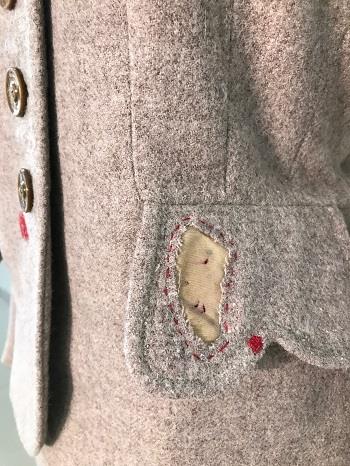Around 700,000 people are killed by antibiotic resistant infections in the world every year, estimates say. Antimicrobials are increasingly overused and misused, while some organisms are becoming more resistant to antibiotics. At the same time, research into new drugs is somewhat slow.
The need to raise awareness on this growing threat has been deeply felt by British artist Anna Dumitriu. For her recent work “Make Do and Mend”, she stepped into the laboratories of the European research project MRG-Grammar (Massive Reverse Genomics to Decipher Gene Regulatory Grammar).
Working side by side with scientists Sarah Goldberg and Roee Amit at the Technion – Israel Institute of Technology in Haifa, Israel, Dumitriu used the revolutionary technique CRISPR, to edit the genome of an E. coli bacterium. She removed an ampicillin (part of the penicillin group of beta-lactam antibiotics) resistance gene and replaced it with the thought provoking phrase “Make Do and Mend” - a slogan in use during the Second World War, which encouraged housewives to mend and darn their clothes - encoded into its DNA.

This unique strain called “TOP10 E. coli Make Do and Mend”, grown onto silk using a dye-containing agar growth medium, was then sterilised and used to patch an antique wartime women’s suit.
In a way Dumitriu used today’s latest technology to return the bacterium to its pre-antibiotic era state. “For me that’s the poetry of it, but scientifically it’s far more complex”, she points out.
“This project is inspired by the 75th anniversary of the first use of penicillin, which occurred in 1941. It was in the middle of the Second World War and clothes and food were rationed. You were told to ‘make do and mend’ rather than buying new things. The British Board of Trade launched the ‘CC41’ logo, which stood for ‘Controlled Commodity 1941’, showing that an item was meeting the government's austerity regulations. It is interesting that clothes were a controlled commodity, but antibiotics certainly were not at all controlled for a long time. So now we have this increasing problem of bacteria developing and evolving resistance, which means many of the antibiotics we have simply don’t work anymore”, she adds.
The Dumitriu’s work with MRG Grammar was carried under the residency programme FEAT, which has seen six international artists hosted by research teams working for the European Future and Emerging Technologies (FET) Horizon 2020 projects.
About synthetic biology and the cutting edge technique used in Haifa, Dumitriu says: “There is a lot of discussion nowadays around CRISPR, as it also has the potential to be used to edit human genomes. Some people say it should be much more controlled, but that’s also quite hard to do.”
“Good artists have intuitive understanding of where society is heading. That’s a mirror put in front us, warning us not to mess with nature technology”, says Roee Amit. He uses a metaphor about their research: “Imagine that an alien spaceship lands on earth with very advanced technologies, 3D printers and stuff like that. It prints pieces and these come together and self-assemble into a fully functional city. Well, it’s as if we were trying to hack that technology, so that we could reprogram it ourselves. In other words, genomics is basically an amazing computer programme”.
“Make Do and Mend” (and other FEAT artworks) will be on show from 28th September 2017 to 18th March 2018 at the Museum of the History of Science in Oxford as part of Dumitriu’s solo exhibition “BioArt and Bacteria”.
youris.com provides its content to all media free of charge. We would appreciate if you could acknowledge youris.com as the source of the content.